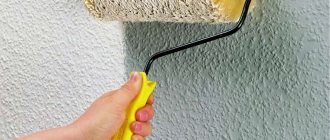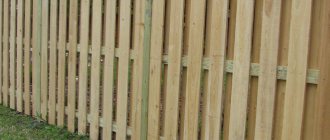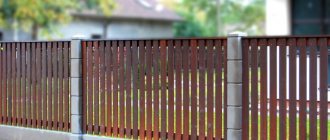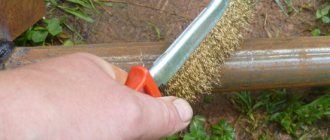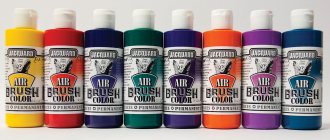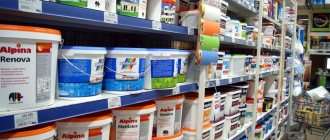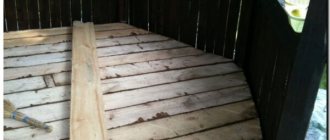Painting the fence is an important process to maintain the decorative appeal of the fence. Concrete is a durable material, but when exposed to precipitation, it absorbs moisture and loses its color under the influence of sunlight. Painting a concrete fence is an effective way to protect the fence from negative external factors and give it a more attractive appearance. Thus, a beautiful fence will highlight the overall composition of your garden plot.
The need for coloring
Concrete fences are made from high-quality cement, giving sections different shapes. The color of unpainted fencing is gray and dull. To enliven the overall appearance of the local area, use a rich palette of colors. The main condition when choosing a color is its combination with the overall architectural composition.
The fence should not distract all attention. Ideally, the color of the fence is in harmony with the roof of the house.
In addition to the decorative need for painting, the fence needs protection from external factors. A layer of paint coating has practical value for preserving concrete fences:
- Moisture protection. Without a layer of paint, moisture quickly penetrates into the internal structure of concrete and leads to the gradual destruction of the fence.
- Protection against freeze and freeze cycles. When concrete is saturated with moisture and the temperature outside is sub-zero, the water in the pores of the material freezes and violates the strength characteristics of the structure.
- UV protection. An unpainted fence does not fade from exposure to ultraviolet radiation, but painted fences need to be renewed periodically - even high-quality paints lose color.
- Protection against mold, whitish spots and moss growth. The fence is constantly exposed to precipitation - a favorable environment for the development of mold microorganisms.
- Protection against the formation of microcracks and chips. Over time, microcracks form on an untreated concrete surface. Priming and painting will preserve the original appearance of the fence.
Coloring plays a big role in terms of decoration. The fence can be treated with matte, shiny, colored and transparent compounds, and shades can be combined to give the structure aesthetic appeal.
Craftsmen recommend painting a concrete fence a few months after installing the structure. During this time, the fence will give the necessary shrinkage. The optimal time of year for painting work is spring, when the air temperature is above +5°C, but there is no extreme heat.
Why do you need to do this?
The fence is exposed to intense destructive influences from the external environment every day. The main disadvantage of concrete is its porous structure. Moisture penetrates into the structure through the pores, which creates a breeding ground for the development of microorganisms. Also, the complex geometric shape of the surface quickly absorbs settling dust and dirt from the street.
Thus, painting a concrete fence is necessary for:
- extending service life and protecting against destruction;
- giving an aesthetic appearance.
Fence protection
Water causes natural leaching of the lime compounds that make up the concrete. This not only provokes corrosion, but also causes salt deposits to appear on the surface of the fence. They form stains, which make the fence look unkempt.
In addition to direct mechanical impact, the appearance of cracks in concrete is also associated with water. During the cold season, moisture freezes and forms ice, which expands when frozen and causes them to appear.
If reinforced concrete blocks were used for construction, then under the influence of capillary effect water can penetrate to the reinforcement. Over time, this will cause it to oxidize and form rust. Delamination will begin between the reinforcement and the surrounding concrete, which will sooner or later inevitably lead to the destruction of the structure.
Molds and bacteria, having settled inside the fence, cause its destruction due to their vital activity. Bacteria feed on the minerals found in concrete. And mold leads to the appearance of cracks due to an increase in the internal stress of the material. Microorganisms also form a specific circular pattern of mold and mildew on the affected area.
Attractive appearance
Painting will not only protect the fence from corrosion, but will also give it an attractive appearance.
The paint will create a protective film on the surface, making it easier to wash off dirt, and dust will not be absorbed deep into the pores of the concrete. If the fence has already lost its attractiveness in places, painting will help hide the presence of visible defects and stop the beginning of the destruction of the structure.
Boring gray blocks rarely match the style of the landscape area. After painting, the fence will match the design of both the house itself and the garden plot.
If you are interested in how to paint a wooden fence in your country house, read this material.
Read about how to make concrete fence posts with your own hands here.
How to paint a concrete fence
Manufacturers of paints and varnishes produce a wide range of products for outdoor use. The paints come in a wide range of colors, so choosing the right shade will not be difficult. You need to purchase paints and varnishes with a reserve - if the composition is not enough, it is difficult to find paint of the same color, since in different batches of goods the shade will differ, albeit slightly.
How to paint a concrete fence:
- Acrylic paint. It has undeniable advantages in terms of resistance to mechanical stress. The composition is environmentally friendly, resistant to moisture, and has good adhesive properties.
- Water-based paint. It is distinguished by its affordability and economical consumption. It has many shades and is less resistant to moisture, temperature changes and mechanical damage.
- Silicate paint. A good choice for treating concrete fencing. The compositions are resistant to precipitation, temperature changes and exposure to UV rays.
- Oil paint. Penetrates deeply into the internal structure of concrete, reliably protecting the fence from any negative factors. Disadvantages: it takes a long time to dry and does not allow air to pass through.
- Latex paint. The basis of paintwork materials is latex dispersion. Resistance to external influences is lower, so the service life of the coating is short.
- Rubber paints. Shows high efficiency when processing concrete fences. Due to the elasticity of the coating, the fence does not absorb moisture.
It is necessary to select a paint composition after calculating the amount of paint to treat the fence from the outside and inside. Painting only the front part will not be able to completely protect the fence from precipitation and loss of strength.
You need to apply the paint in at least two layers - this ensures color saturation and thorough painting of minor defects. If desired, the composition is applied in three to four layers.
Advantages of designs
By choosing a concrete fence, the consumer gains a number of potential advantages:
- aesthetic appearance - the owner’s preferences are easily expressed in form;
- affordable price range is a distinctive feature that does not affect quality;
- quick installation – depending on the length, professional installation is carried out within 24 hours.
Proper operation will ensure long-term service and reliability.
Choosing a tool for the job
The decorative concrete fence consists of several sections. A common option is three segments. The lower part can be painted a darker color to highlight the beautiful appearance of the fence. Sections of fences can be blank or with holes if plants are planted near the fence. To apply the composition correctly, use various tools:
- It is convenient to use a roller to process continuous sections of concrete fencing. The composition is evenly distributed over the surface.
- Brushes are used to paint complex structural elements, joints and support pillars;
- The spray gun is used for economical processing of blind fences. Relevant when painting high and extended fences.
- The paint tray is used for working with a roller. Paints are poured into it and excess compositions are removed on the ribbed surface of the tray.
- Solvents. Some types of paint become thicker as you work. You can add solvent to them and wash the instrument with it.
- Dye. The finished compositions are thoroughly stirred, and to prepare water-based paint of the desired shade, they are tinted.
To avoid getting your hands and clothes dirty, use a suit and gloves. Wear goggles to protect your eyes, and you can use a respirator to prevent inhalation of toxic substances. Brushes are selected in different sizes for painting small and large decorative parts of the fence. Some craftsmen paint smooth sections to look like stone, then additional masking tape is needed for the job.
Preparing for coloring
Painting a concrete fence begins with cleaning the structure from any dirt and old paintwork. To do this, sections are generously moistened with soapy water, left for 15-20 minutes and cleaned with a stiff brush. After this, the fence is washed with water and allowed to dry.
Old paintwork is removed with special paint removers.
Metal elements are cleaned of rust and treated with an anti-corrosion compound. If there are cracks in the concrete surface, you need to cover up the flaws with ordinary cement mortar. To prepare, take sand and cement in a ratio of 3:1 and dilute the mixture with water. Cracks are covered with a spatula or trowel. The prepared surface must be primed. Primer Process Requirements:
- Paints and primers should be of the same type and preferably made by the same manufacturer.
- A water-based primer is used for surfaces that have not previously been painted;
- Organic-based soil is used for deep impregnation of a fence made of low-grade concrete.
- The primer must be applied to the front and back sides of the fence using a roller or brush.
- Painting is performed after the impregnation has dried. Drying time varies from 12 to 24 hours - depending on the composition.
- Organic primers can be applied at sub-zero temperatures, except for polyurethane primers.
- Water-based compositions are well absorbed into the concrete base at high air humidity.
To ensure that nothing interferes with the priming and painting process, plants planted near the fence are carefully tied up, and if possible, decorative elements decorating the garden plot - sculptures, benches, small architectural forms - are removed. The strength and durability of the paint and varnish coating depends on the quality of the primer, so you should not skimp on impregnation compounds.
On video: how to beautifully paint and tint a concrete fence.
Fencing painting process
Painting of a concrete fence is carried out after the primer has completely dried and in good weather conditions. You cannot start work if the forecast predicts precipitation - the paint will not have time to dry and will partially lose its protective qualities. Coloring does not take much time. Sequence of work:
- Preparation of the working composition - open the paint and mix thoroughly. If white water-based paint is used, dilute the composition with color until the desired shade is obtained;
- Painting corners, decorative elements and hard-to-reach areas with a brush. If the fence is painted in several colors, there should be no more than three shades;
- Applying the base layer with a brush, roller or spray gun. How to paint? You need to ensure that the paint does not leave streaks, carefully spread the composition over the concrete surface;
- Start painting from the upper sections so as not to stain the lower segments. It is appropriate to use a roller for smooth surfaces, a spray gun for relief shapes, a brush for small details;
- Apply the first coat of paint, allow the coating to dry and paint the surface again. For uniform, rich coloring, two layers of coating are sufficient.
An ordinary gray concrete fence will become attractive if you paint the concrete fence to look like stone. First, the fence is painted in a base color, the coating is allowed to dry, and then the stone surface is painted. To do this, the fence is marked with a pencil into separate sections - according to the shape of the simulated stones.
Apply masking tape along the markings. After this, unpasted areas are painted over. When the paint is dry, remove the tape. The “stone borders” will be the selected base color.
Selection of paints and varnishes
When choosing materials, fundamental importance is attached to their characteristic features. In order not to get confused in the wide range of paints for concrete fences, you should understand their inherent properties.
- Silicate . Vapor-permeable paint is based on liquid glass. It has good contact with the surface, has unusual water resistance, prevents the formation of fungi and mold, and is not susceptible to aggressive chemicals.
- Water-based . Contains polymer particles and pigments. Advantages: reasonable cost, variety of color shades, the mixture dries quickly without cracking. Disadvantages - susceptibility to temperature fluctuations, humidity, damage.
- Acrylic . A classic version of water-dispersion paint. When dried, it loses its properties - dissolving in liquids. Resistant to sunlight and moisture, and is highly environmentally friendly. When choosing a color, take into account slight darkening after application.
Technology of applying paint to the surface of concrete using a spray gun Source arka-green.ru
- Latex . Chemical base – acrylic copolymer. It is not durable, but latex gives the paint material a different glossy finish. A characteristic feature allows you to create a brilliant reflective effect.
- Rubber . The uniqueness of concrete paint is its ability to change physical properties with temperature changes. The elasticity of the material ensures heat resistance, waterproofing capabilities, and resistance to the influence of negative factors.
- Oily . The coating protects the painted surface from external influences, the colonization of microorganisms, the accumulation of dirt, and vapor permeability. The weak link is a short service life, rapid fading.
When purchasing a painting material, you should make sure that it is intended for outdoor use. An essential detail - matte paint masks small defects well, while gloss emphasizes it.
Painting concrete with acrylic paint using a brush Source radiomoon.ru
How to choose a color to paint
When painting a concrete fence, you can use a creative approach or a practical method. The easiest way is to paint the fence one color using a spray gun. But sectional and artistic painting can give the structure an original look. In the first case, structural elements are highlighted in contrasting shades. An example is a dark main background, light decorative elements at the top of the spans.
Artistic painting is painting a fence with an imitation of a wooden or stone surface.
What paint to paint a concrete fence? You can use any creative solutions, provided that the design is not too colorful and “flashy”. Some recommendations for choosing colors:
- Colorless paint is used on high-quality fences without defects or flaws;
- White color goes well with any basic background. It is used for painting decorative structural elements.
- When choosing a color, take into account the relief of the sections: for stone - gray and brown, for brick - beige, sand shade.
- If there are bright ornamental plants and flowers on the site, the fence can be painted green with elegant white details.
- A cool blue shade is appropriate if the roof of the house is made in the same color scheme.
- Shades of red look impressive against the background of white brick columns installed at gates and gates.
The color of the fence is a matter of taste, but the use of bright colors should be in harmony with the surrounding landscape. A lurid fencing of all the colors of the rainbow will only shock those around you. If there are no creative ideas, it is better to use calm neutral shades. A beautiful fence decorates the house and gives the building a nice finished look.
Decorative painting of a fence (2 videos)
Fence painting options (27 photos)
OLYMPUS DIGITAL CAMERAPainting a concrete fence: DIY options
A concrete fence is the most durable and quickly erected fencing option, and at an affordable price. But if you don’t take care of the safety of the fence in advance, it may well quickly collapse from the influence of various factors, differences in temperature and precipitation. To prevent this from happening, there is a method of protecting the fence, such as painting a concrete fence: it is quite possible to do it yourself. In addition, painting it in an interesting, bright bronze color will save the concrete fence from dullness, monotony and dullness.
How to paint a fence?
Technology
By painting the stone fencing around your home or office, you will not only significantly extend its service life, but also turn this gray structure into a real work of art that fits perfectly into the architectural ensemble of city streets, as seen in the photo. At the same time, you should be very careful when choosing a material for painting, which must withstand at least one winter season.
Beautiful fence
The work is carried out in a certain order, and it all begins with preliminary preparation, followed by priming the surface base and painting.
Before starting work, you should take care of purchasing tools and materials. You should stock up on a spatula, a sprayer, a brush, a brush, a roller, a sheet of plywood and an extendable handle. As for materials, you will need paint, primer and bioprotective impregnation.
Preliminary preparation
The surface must first be prepared for applying paint in bronze or another color. It is necessary to clean off all kinds of dirt and other debris, for which you will need a spatula and a harder brush. Do not neglect this rule and clean even very long fences. In addition, this will allow you to thoroughly examine the surface and view all damage and flaws.
It is advisable to carry out preparatory work in good weather with an air temperature of 10-25°C, without precipitation, wind or burning sun. In addition, drying is simply impossible at night temperatures below 5 ° C.
Primer
After cleaning the surface, the stage of priming begins, for which impregnation from mineral bases, such as Tikkurila Euro Premier, is used. This process is carried out using a brush, brush or roller and is carried out in one go. Drying continues for 24 hours, after which it is necessary to remove all irregularities using a spatula and dry the surface again for 24 hours, then sand, clean and prime again, followed by drying for an hour.
Recommendations
Painting the fence must be done on a well-primed surface in two layers. It is necessary to maintain a certain twelve-hour interval between painting to imitate stone or other textures. To do this, use a roller, brush or sprayer, and the latter tool will help to significantly speed up the painting process, and will also allow you to apply the paint in a more even layer, reaching all hard-to-reach places.
If you use a roller, the bronze or other color paint applied with it will last longer. As for brushes, they best allow for quality control of the work process. An excellent result can be achieved by combining staining methods.
The extendable handle will help ensure good coverage of areas that are difficult to reach. The pen will also help in painting areas behind the bushes. You can also use cardboard or plywood sheets, placing them between the painted fence and plantings. Do not forget about the areas where pillars, slabs and fence tops are connected, which should be carefully painted.
Paint selection
If you plan to carry out external processes on concrete, then choose dispersion acrylic solutions that will protect the surface from moisture and aggressive agents. As an option, you can consider paints “Kivisil”, “Tikkurila”, Mineral Strong, Mineral Gamma. Before using any paint, even bronze, you need to mix it thoroughly and buy several cans, preferably from the same batch, to avoid differences in shades. After finishing painting, the surface must be protected from moisture and dust for two days.
If you are thinking about choosing a color for your fence, here are some tips:
- Blooming flowers will look great behind a green fence, but the white color of the fence will add tenderness to the surroundings, as can be seen in the photo;
- When painting the fence, you should not use more than 3 colors;
- It looks great when the color of the fence is similar to the color of the building tiles;
- The fencing of a more modest building is best painted in light colors, such as peach, beige or brick;
- The lower part of the fence is painted in darker colors, and the upper parts in lighter colors;
- If the shape of the fence is similar to masonry, then it should be painted to resemble the stone, as can be seen in the photo;
- The graffiti technique would look appropriate on smooth slabs. To do this, you can choose a cute ornament or several beautiful colors;
- You can use the technique of combining different shades of the same color, which looks very attractive;
- To fence a house where there are children, you can consider the option of a fence with a pattern of children’s hands or brighter splashes made by the children themselves;
- Do not use too saturated colors for dyeing, as they may soon begin to irritate. It is better to opt for lighter shades.
Let's sum it up
Painting a concrete fence is a completely simple task, and sometimes quite fun. Involve your whole family in this activity, and everyone will love it, especially the kids. Give the children paint balls and ask them to throw them at the fence and gradually, with the help of the game, you yourself will not even notice how you paint the fence in your favorite colors.
zabornyi.ru


